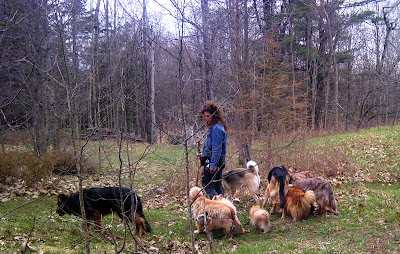DOES YOUR DOG OWN YOU?
 |
| Robbie my Boxer x, and me! Partnership, not ownership |
A common concern of my clients is that their dog is guarding and owning them. This is a serious situation that should be addressed and resolved right away.
Unwanted guarding or ownership of a person by a dog is a symptom of a much bigger issue: lack of understanding leading to an absence of required coaching, mentoring, and structure for the dog.
Some people may at first, find this type of behavior cute or be proud their dog’s ‘ownership/guarding’ behavior.
The problem is, the behavior is not good for the dog. Also consider if you do not know how to control the behavior the result can be traumatic for both dog and human.
To help you better understand the dangers inherent in allowing your dog to ‘own’ you, I am going to provide a real life example below. This happened to some one I know in an animal discussion group that I participate in.
The other group member posted the following:
I have had a French Poodle, pitch black, of high pedigree. He was very possessive over me, nobody could pass me or come close, either animal or person. I also had another Maltese x Poodle at the time, who I was I was very fond off. One day I tried to pick the Maltese x Poodle up for a bath and French Poodle turned around attacking me, but I still think it was because he was jealous and did not like the idea that I took noticed of my other dog. I landed in hospital and when I came out I was told that my French Poodle has been taken to the Vet and put down. I will never forget the grief – and even though it is more that 10 years ago, I sometimes still feel sadness for him.
I have had a French Poodle, pitch black, of high pedigree. He was very possessive over me, nobody could pass me or come close, either animal or person. I also had another Maltese x Poodle at the time, who I was I was very fond off. One day I tried to pick the Maltese x Poodle up for a bath and French Poodle turned around attacking me, but I still think it was because he was jealous and did not like the idea that I took noticed of my other dog. I landed in hospital and when I came out I was told that my French Poodle has been taken to the Vet and put down. I will never forget the grief – and even though it is more that 10 years ago, I sometimes still feel sadness for him.
This person still has dogs, as do many others in the group – the need to understand and avoid this situation in the future was of concern to all. They asked my advice on how to avoid and or treat this situation should any one by currently dealing with it, or encounter this type of behaviour in the future.
When working with clients I always start by explaining the psychology of a situation. Having a clear understanding of the root causes, effects and outcomes of behavior is vital to understanding the solution and preventing the development of the same situation in the future.
PART ONE – Understanding the Situation
This dog was dominating and owning his human. To teach personal space you have to mindfully communicate to your dog that your body and space is your, not his. By mindfully moving into the space your dog occupies, you take the space back from your dog. Keep uppermost in mind that this should never be approached with an aggressive, dominating attitude. It must always be done from a place of mindfulness and normalcy. You want your dog to be mindful, respectful, grounded - you must first be that thing you want your dog to be.
If your reaction to him being in your personal space has always been for you to withdraw from the space you have enabled the behavior. If your reaction has always been to allow your dog to remain in your personal, you have enabled the behavior. It's important to acknowledge your part in creating the unwanted behavior, as this will help self-correct and move forward.
Human jealousy exemplifies itself in many forms – an insecure partner will often jealously dominate and own their spouse. If you used this specific instance/description of jealousy you would be – pretty close – to describing what was going on between yourself and your dog. Your dog is owning you and your space.
Most people do not realize what is happening, and think that the dog is simply being protective or even cute. This is not protective – it is ownership of the human exemplified by dominating behavior. When a dog is being protective of you he is not ‘owning’ you.
The mistake most people unknowingly/unintentionally make is in not understanding the true root of the behavior.
Ownership/dominating behavior is not the issue – it is a symptom of the issue. The issue (the root cause) is that the dog is making unhealthy decisions because he does not have the structure in-place nor the experience to make alternative healthy decisions.
It is the human's responsibility to provide the dog with the coaching and mentoring needed in all daily-life situations.
Left unchecked the dog will continue to take over. His behavior will escalate and eventually it is likely that he will attack another dog or a human.
This type of behavior and its potentially dangerous outcome is completely avoidable.
This dog was not a bad dog, it just hadn’t been told the right way at the right time not to ‘own’ its human. The dog did not have a the coaching and mentoring he needed. In the absence of proper coaching and mentoring, rules and boundaries – the dog made his own rules.
PART TWO – Understanding How to Provide The Structure Your Dog Needs
First and foremost you must emotionally disengage. You cannot provide the mindful coaching and mentoring needed when you are emotional. Remember that you must lead by example, you must be that thing you want your dog to be. Grounded, mindful, respectful.
Never, ever try to correct your dog when your mind and energy is aggressive, angry, frustrated etc. Why?
Because at best you are being hypocritical – your state of being is no better than your dogs. Your dog will know this and not listen to you.
Worst case scenario – you can evoke the ire of your dog and be the cause of aggression.
Be mindful. There is no place for emotion, tension, fear, frustration. Be patient, be persistent.
So to sum this up – be 100% committed to persistance from a place of mindfulness. Never give-in, never let any of this behavior pass without disagreeing, correcting, directing and follow through from a place of mindfulness.
And lastly, remember never, ever match your dogs unbalanced state – your must be the polar opposite, mindful. But you do need to match the intensity of your dog’s energy. Mild, gentle but firm mentoring for low intensity behavior, more intense but always mindful mentoring for more intense behavior.
PART THREE – How to Prevent ‘Ownership’
Directions to dogs should always be provide in three parts – get their attention, disagree if you do not like what they are doing and follow through by showing them what to do instead.
I run into this situation often with my clients. I teach my clients how to instantaneously disagree – I train them to be the pack leader, and show them how to coach and mentor their dog.
So, should this ‘ownership’ situation ever happen between you and your dog…
1) Never, ignore the behavior, always provide your dog with the coaching and mentoring he needs.
2) Catch the behavior as early on in its development. Be aware, be mindful, pick-up on its presence and address right away.
3) Then immediately review other aspects of your human-dog relationship and ensure that you are providing your dog with support in all little situations in daily life. If you find gaps step up your leadership.
It is really important to catch this behavior as early on as you can:
First and foremost, because it indicates that you need to ramp-up your leadership position. Your leadership skills may already be very solid but just need a little more attention when it comes to your dog trying to own you, or it may indicate that your overall performance as leader needs a review and boost.
If the behavior is in the EARLY stages of development, you can use the techniques I provide below to address and correct this behavior.
If the behavior has become ‘well-ingrained’ and has escalated to a more intense degree, unless you have experience with this kind of thing you need to engage professional help. Do not attempt the techniques provided below you. Engage a professional – but make sure that the professional you engage really understands the psychology of the situation.
To assess the professionals ability to properly address this situation ask the person how they intend to resolve the issue. If they say that they will use tools such as (e-collars, pinch collars, treats, etc) as their primary method of intervention, this person is not the one you want to engage. If they say that they will use a combination of methods – human & dog psychology first and foremost you are on the right track. They should ask you questions that indicate to you that they understand that this type of behavior does not exist in isolation – it is only one symptom of a bigger issue – lack of leadership.
Remember, it is always easier to correct an issue/behavior in its early stages than when it is fully and completely ingrained and escalated. Never ignore or avoid – address early.
So if your dog is the early stages of developing this ‘ownership’ (dominating) behavior.
When the behavior happens…
1) Get your dogs attention – you can quickly calmly (without emotion), firmly touch them (at the side of their neck, waist), snap your fingers, say ‘hey’ (make sure your tone is calm, low, clear and strong), etc – what ever you find works to get their attention;
2) Tell them ‘no’ (same tone of voice as above) and back the dog out of your space (walk into the space they occupy or use your body by just leaning in or toward the dog, or use your hand/arm to point them away. The technique you choose just depends on what works well for you and your dog;
3) Follow through, make sure your dog stays out of your private space. If your dog moves back in to your personal space, just back him out – be more persistent and committed than he is – this is a psychological test of wills – your will to succeed must be stronger than your dog’s.
4) Then tell your dog what you want it to do (i.e. sit, lie down or leave the space and go elsewhere, etc.)
5) Once you have accomplished this – sit back and access your leadership – is the gap just over this behavior or is the gap in your leadership deeper. If your leadership is not prevalent enough in other ways take immediate measures to strengthen it ASAP.
1) Get your dogs attention – you can quickly calmly (without emotion), firmly touch them (at the side of their neck, waist), snap your fingers, say ‘hey’ (make sure your tone is calm, low, clear and strong), etc – what ever you find works to get their attention;
2) Tell them ‘no’ (same tone of voice as above) and back the dog out of your space (walk into the space they occupy or use your body by just leaning in or toward the dog, or use your hand/arm to point them away. The technique you choose just depends on what works well for you and your dog;
3) Follow through, make sure your dog stays out of your private space. If your dog moves back in to your personal space, just back him out – be more persistent and committed than he is – this is a psychological test of wills – your will to succeed must be stronger than your dog’s.
4) Then tell your dog what you want it to do (i.e. sit, lie down or leave the space and go elsewhere, etc.)
5) Once you have accomplished this – sit back and access your leadership – is the gap just over this behavior or is the gap in your leadership deeper. If your leadership is not prevalent enough in other ways take immediate measures to strengthen it ASAP.
Holistic Diet, Nutrition, Wellness Services Tailored to Your Individual Dog and Cat
For information about my holistic diet, nutrition and wellness services, visit my holistic wellness services page.
Maintain good health | Address acute and chronic health issues | Pre and post surgery support and recovery
My holistic wellness services are available worldwide via video consultation.
🌎 USA | Canada | UK | Europe | Australia | New Zealand | Asia | South and Central America | Africa | UAE
📱FaceTime | Facebook | Skype | WhatsApp
To set-up your holistic wellness consultation get in-touch via email, go to my contact me page.
Holistic Behavioral Services for Your Dog
For information about my holistic behavioral services, visit my holistic behavioral services page.
For dogs of all ages, sizes and breeds.
My behavioral services are available worldwide via video consultation.
🌎 USA | Canada | UK | Europe | Australia | New Zealand | Asia | South and Central America | Africa | UAE
📱FaceTime | Facebook | Skype | WhatsApp
To set-up your holistic behavioral session get in-touch via email, go to my contact me page.
Affiliations to Companies
✓ None.
✓ I don't sell food, supplements, or other products.
✓ I'm not aligned with any companies.
Article and graphics by Karen Rosenfeld.










